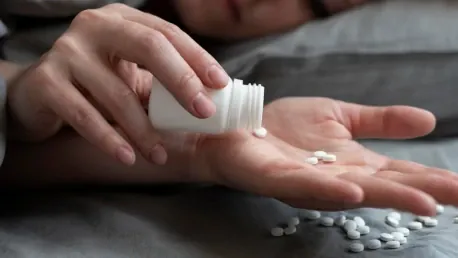During the COVID-19 pandemic, the United States witnessed a profound transformation in the treatment landscape for opioid use disorder (OUD). Due to the urgency of social distancing measures and the heightened demand for accessible healthcare, regulations were adjusted to permit the telehealth prescribing of medications like buprenorphine without necessitating an initial in-person visit. As the year draws to a close, however, these pandemic-era flexibilities face the threat of expiration, prompting a concerted bipartisan effort to ensure these critical measures remain in place to combat the ongoing opioid crisis effectively.
Significant Benefits of Telehealth for OUD Treatment
Telehealth has dramatically altered how patients with opioid use disorder receive treatment, proving to be a game-changer in the fight against the opioid epidemic. By eliminating the requirement for an in-person visit, telehealth options have substantially broadened access to life-saving medications like buprenorphine. This shift has been especially beneficial for patients in rural or underserved areas, who might otherwise face considerable difficulties in obtaining the care they need. The convenience and enhanced accessibility facilitated by these relaxed regulations have led to a significant increase in both the uptake and retention of treatment for many individuals suffering from OUD.
Buprenorphine, recognized for its efficacy, stands out as a partial agonist that offers effective treatment for opioid use disorder with a comparatively lower risk of misuse than full agonist opioids. The telehealth flexibilities allowed during the pandemic have enabled a more extensive patient population to access this essential medication safely and promptly. This increased accessibility is credited with playing a pivotal role in reducing opioid use-related fatalities, underscoring the importance of continuing these measures to address the ongoing crisis effectively.
Legislative Support and Advocacy
Representative Annie Kuster (D-N.H.) and Representative Carol Miller (R-W.Va.) have been at the forefront of the legislative push to maintain these telehealth flexibilities, expressing significant concerns over the potential tightening of regulations by the Drug Enforcement Administration (DEA). These lawmakers have formed a bipartisan coalition dedicated to urging the Biden administration to extend the current pandemic-induced telehealth provisions. They argue that the evidence collected over the past few years compellingly supports the continuation of these measures, highlighting the direct positive impact on public health and the reduction in overdose deaths.
This bipartisan coalition aims to leverage its cross-party support to emphasize the public health necessity of keeping telehealth accessibility for OUD treatment intact. The increase in treatment accessibility, they argue, has had a tangible and positive effect on combating opioid overdose deaths. By uniting their efforts, these legislators seek to draw attention to the critical benefits that have been realized during the pandemic, advocating for the sustained adoption of these telehealth policies.
Regulatory Challenges and Potential Impact
While there is robust advocacy for the extension of telehealth prescribing flexibilities, there is also considerable apprehension about the potential imposition of more stringent DEA regulations. Future restrictions, such as mandatory in-person visits or special provider registration, could present substantial obstacles for patients seeking buprenorphine treatment. These additional barriers risk reversing the significant progress made in expanding treatment access over the past few years, potentially reducing the effectiveness of efforts to combat the opioid crisis.
Healthcare providers share these concerns, noting that a return to pre-pandemic regulations could severely disrupt the advances achieved through the adoption of telehealth. The increase in telehealth utilization during the pandemic has not only made treatment more accessible but has also normalized the use of these technologies in everyday practice. If the measures are rolled back, patients—particularly those from vulnerable populations who have come to rely on the convenience and accessibility of telehealth services—might find their pathways to treatment obstructed once again.
Balancing Accessibility and Safety
The ongoing debate over the extension of telehealth flexibilities involves striking a delicate balance between ensuring accessible treatment and implementing appropriate regulatory measures to maintain safety and prevent misuse. Buprenorphine’s unique pharmacological properties reduce its potential for abuse, reinforcing the argument for preserving easy access through telehealth channels. This balance is essential to ensure that the benefits of increased accessibility are not overshadowed by undue risks.
Public health experts stress the importance of prioritizing the removal of barriers to treatment during the ongoing opioid crisis. The relaxed telehealth regulations introduced during the pandemic have already demonstrated their efficacy in expanding the reach of treatment and reducing mortality rates associated with opioid overdoses. Ensuring that these life-saving measures remain in place is seen as crucial to continuing the progress made in combating the opioid epidemic. Engaging in ongoing discussions about how best to balance these priorities will be key in shaping the future of OUD treatment policy.
Moving Forward with Evidence-Based Policies
During the COVID-19 pandemic, the United States saw significant changes in how opioid use disorder (OUD) is treated. As social distancing became necessary and the need for easy-to-access healthcare grew, rules were altered to allow telehealth prescriptions of medications such as buprenorphine without requiring an initial face-to-face appointment. This shift made it easier for patients to get the help they needed despite the restrictions caused by the pandemic. Now, as the pandemic wanes and the year draws to a close, these special, temporary measures are in danger of ending. This possibility has sparked a bipartisan push to make sure these essential telehealth provisions remain in place. Policymakers recognize that the opioid crisis is far from over, and maintaining these relaxed telehealth regulations could be crucial for continuing the fight against OUD. Keeping these changes could help ensure that people suffering from opioid addiction have ongoing, flexible access to the treatment they need, helping to save lives and reduce the impact of the opioid epidemic on American society.









